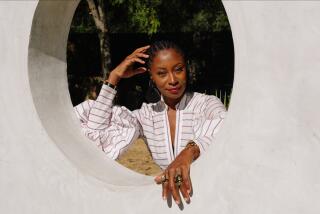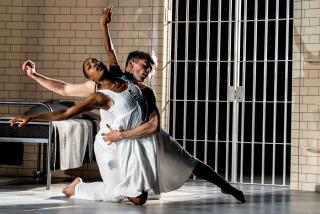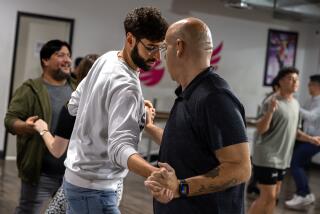Dance in unexpected places
Times' critics and columnists review the best places on Earth to pursue their passions.
•
•
•
•
•
•
•
•
•
•
•
The Barbakan area of this city’s Old Town teems with antique splendor: church spires, gingerbread houses, brick towers, even a nearby drawbridge. But tonight the members of a 4-year-old dance collective named Bretoncaffe are throwing themselves against the walls in “Slam,” a free, outdoor performance that depicts trapped energy curdling into fierce aggression.
Performing in a gap between a row of houses, the four dancers swing off metal guardrails, jump high to hang from windowsills, crash down onto concrete planks and spring up again into unpredictable confrontations.
If sexual ambiguity colors the interaction of the two men, the lust for power fuels the women’s dancing, and soon the cordless microphone held by rock singer Dominik Strycharski becomes a symbol of dominance. Attracted by the lights, the music and the sight of young people rebounding against the walls, an audience gathers — standing on two sides of the performance or finding a place to sit on a low brick wall or the ground.
Street theater and street dance often are considered subprofessional, maybe because they’re free. But the invention, intensity and technical skill of this performance would make it welcome almost anywhere. And I’m here and nowhere else because Eastern European contemporary dance — and Polish achievement in particular— is increasingly considered on the cutting edge in the dance world.
The first thing I learned on my journey of artistic discovery was not to head for any one place. Right now, the essential story of Polish contemporary dance is a tale of three cities.
My second lesson is emphatically declared by Bretoncaffe director Slawomir Krawczynski.
“The situation for contemporary dance is very difficult in Poland,” he says after the performance, with choreographer Anna Godowska nodding in agreement. “We’re fighting for people’s consciousness about dance.”
That’s no exaggeration. Until recently, contemporary dance was largely an underground phenomenon in Poland, a kind of cultural stepchild as far as official recognition was concerned. The nation’s well-known folk companies and ballet institutions continued to receive government support, but even the most acclaimed, innovative contemporary choreographers had to piggyback on theater or music budgets to get their projects funded by the Polish Ministry of Culture. Even then, the money was doled out in such a way that long-term planning became virtually impossible.
However, a new visibility is in the offing. Where formerly you could catch the hottest, sharpest companies only in a welter of annual festivals — many of them staged to maximize publicity in a country with few dance journalists — you’ll soon be able to visit several independent venues offering year-round performances.
One will be at Warsaw’s historic Ujazdowski Castle, originally a 13th century stronghold, then a hunting lodge, a Baroque palace, a hospital, a barracks, a burned-out, bombed-out ruin and, after a 20-year reconstruction, the imposing home of the Center for Contemporary Art.
Just above its interconnected galleries and exhibition halls lie the offices of Akademia Ruchu, for more than 30 years a bastion of and ambassador for contemporary dance-theater in Poland. (The company visited Los Angeles in 1992.) Artistic director Wojciech Krukowski expects a new 200-seat dance stage on the castle grounds to be ready a year from now, allowing him to increase his company’s performing schedule in Warsaw (currently twice a month, in rented spaces, when not on tour) and offer a showcase for other troupes as well.
Krukowski is especially enthusiastic about how membership in the European Union has created new cross-border artistic partnerships for dance. “Polish-German and Polish-Czech initiatives,” he says, “with five times more possibilities than before. Bureaucracy is not as important anymore as the energy of the artist, so it’s the best possible time for any independent dance group. It’s a whole new era in our theatrical life.”
Down below Ujazdowski Castle — and the scaffolding that will become Krukowski’s theater — sits the elegant Lazienki Gardens, where you can drift on a swan boat, be dwarfed by an enormous monument to Frederic Chopin and watch peacocks sing for an audience of pigeons in an intimate Greco-Roman amphitheater. Not far away is the Royal Palace, a monument to the Jewish ghetto and other major tourist sites.
Poland’s capital is overpriced as a tourist and dance destination, so don’t linger too long. Just a few hours away by express train, you can find unique landscapes and choreographies.
Using Warsaw as a hub, traveling by train in Poland is cheap and efficient. When buying tickets or seeking directions, remember that young people probably speak more English than their elders.
As for mastering the difficulties of Polish pronunciation, take a tip from a character in George Bernard Shaw’s comedy “Misalliance” and rapidly repeat the words “fish-church” a few times before trying to utter any tongue-twisting name.
Inexpensive, but culturally rich
ALTHOUGH Poles think of Poznan as a business center, this city of 570,000 boasts nearly as much architectural gingerbread as Warsaw, an imposing Gothic cathedral with a golden chapel and a Renaissance town hall that rivals anything in Krakow, with two tin goats that appear on its tower every day at noon to butt their heads.Expect to find intriguing cultural oddities — a charming statue, an exquisite small church, a monument to the years of rebellion — around nearly every corner and to spend half of what you would in the capital only 171 miles away.
The city has been a center for contemporary dance since the founding of Polish Dance Theater in 1973. Writing about the company on its 25th anniversary, cultural reporter Ewa Obrebowska-Piasecka remembered “watching the troupe evolve, watching how it was leaving behind the petrified tradition of ballet learned in school to enter the complex and multifarious age of postmodernity.”
Today, Poznan postmodernism has a new home atop a downtown maxi-mall: Stary Browar, a red-brick monument to contemporary art, with several exhibition and performance spaces on three floors, carved out of a former brewery.
“Before the studio spaces in Stary Browar were opened, there was no regular year-round place where people in Poznan could watch dance,” says Johanna Lesnierowska, who curates and programs the center for the Kulczyk Foundation. “There was a great hunger for this because the presence of Polish Dance Theatre already educated the audience.
“We are filling a gap, introducing the audience to the new trends of research in dance, to choreographers who are looking for new definitions of dance.”
Among the discoveries in Stary Browar’s first year: the dancing iconoclasts of Teatr Dada von Bzdulow. This group from the city of Gdansk performs the collaborative “Several Witty Observations,” a propulsive, free-form exploration of themes from the writings of celebrated Polish author Witold Gombrowicz.
Using large, transparent air mattresses as props and sometimes as partners, the three dancers increasingly focus on the theme of identity theft — not merely the act of stealing credit cards or an identification number but appropriating someone else’s personality, even if that means assuming a new gender.
Along the way, all sorts of deliberate fake-outs take place involving disruptive lighting and sound effects, and the cast’s passing out slips of paper to the audience and even deflating the air mattresses. But the forceful, technically sop histicated dancing is never anything to laugh at. That is, not until the men lumber through a brilliant parody of that new cliché of contemporary dance, the oh-so-sensitive male duet — here, a disastrously clumsy, sweaty gymnastic tangle.
“This piece is full of meaning, with lots of levels,” Leszek Bzdyl, the company’s charismatic firebrand, says at lunch the next day. “There are technical levels, dramaturgy levels, levels of emotion. Some people look at it as a game involving the techniques of dance. Others see Gombrowicz. The rest might see it just as a crazy time. That’s how we built it. Because at this moment, we are for everybody.”
The same week, a radically different style of accessible contemporary movement theater is offered just outside Poznan on Lake Malta, usually the site of an enormous family amusement park. Across the water from its trampolines and giant rooster and clown slides stands an enormous plum-colored tent in which a former member of Cirque du Soleil and several veterans of Polish dance and theater ensembles have staged “Ocelot — the Spirit of Artistics.”
Reminiscent of Cirque du Soleil
CIRQUE fans would find the expressive content familiar — fantasies and nightmares, temptresses and monsters, rock exotica — all experienced by the kind of ordinary guy who just might be plucked from the audience. But this is a small company (17 performers plus musicians) for this kind of challenge, so versatility is at a premium. Everybody has a specialty — and a lot of sidelines too.Piotr Wasik, for example, functions as a snake dancer, contortionist and aerialist, and in all of these areas he is pretty much world-class all the way.
What “Ocelot” needs is simply a way of focusing its remarkable cast — and its intrinsically Polish identity.
Although Silesia was originally the charmingly rustic part of Poland where the 1870 ballet classic “Coppelia” was set, this region has been heavily industrial for so long that it is way off tourists’ radar.
Here you’ll suffer Gingerbread Deprivation Syndrome. Until recently, steel mills and coal mines polluted the landscape, undercutting such tourist-friendly enticements as a silver mine founded in 1492, historic wooden churches and storybook castles.
Many factory towns in Upper Silesia are reportedly sinking down, down, down into the abandoned coal pits underneath, but one of them — Bytom, a few minutes outside sprawling Katowice (population 317,000) and just 160 miles from Warsaw — houses what is arguably the most influential contemporary dance center in Poland.
Jacek Luminski will tell you that he founded Silesian Dance Theatre in Bytom 15 years ago partly because the local government and inhabitants wanted to establish a cultural institution to bring recognition and respect to the region.
But he also founded it, he says, because “Warsaw and Krakow always have the pretension that they have the culture that is the best developed in Poland. They never wanted to investigate any new sources for artistic growth.”
Their loss. Within a short time, Luminski gave Bytom an innovative, high-profile company as well as community outreach and audience development programs, professional workshops and seminars, and an annual festival that provides local audiences with exposure to a range of Polish contemporary dance.
On the same balmy Bytom night, for instance, you might see Victoria Fox’s “Déjà Vu,” a breezy piece for Dance Theatre “Direct” that makes a legless woman in a wheelchair the equal partner of two dancing gymnasts. Or Ryszard Kalinowski’s brooding solo “Bellissimo” for Lublin Dance Theatre, in which the superb Wojciech Kapron starts off consumed by pain but achieves a metaphysical state of grace.
Silesian Dance Theatre performs two or three times a month in Bytom and tours widely. (It visited Los Angeles last year.) Luminski plans to establish a school of contemporary dance and is developing a university curriculum to improve and standardize dance studies.
Like so many other Poles in the arts, he is optimistic about the future — though the influence of globalization and, particularly, television alarms him. That alarm is central to his new piece for the company, “Glamour of Mundane — Dream From a Saint,” which shows a dishy fallen angel with a mohawk mourning the brutalities of modern life and relationships.
The piece shocks some longtime company observers by abandoning dance expression in an audience participation segment satirizing game shows and reality TV, with mindless commercials also on its list of targets. But Luminski’s sophistication as a choreographer proves inarguable during passages of intricate, forceful dancing on and beneath a multilevel scaffolding he designed.
By no coincidence, the work’s deliberately raw juxtaposition of approaches and styles reflects the major tensions and junctures of millennial Polish life. In Silesia, the closing of the coal mines has brought cleaner air and water to the region but also unemployment and political upheaval. Elsewhere, a new compulsion to embrace all the freedoms impossible under Communism has made the radical heroes of a few years ago sound like reactionaries.
This year, Lech Kaczynski, the mayor of Warsaw — who is running for president in an election to be decided today — banned the annual gay pride parade in that city. But it took place anyway, with the cooperation of the police and several public officials. More significantly, it attracted hordes of people with no special interest in homosexual rights but who saw the parade and ban in larger terms: as an example of embattled freedom of expression.
Poles have lost too many freedoms too often to let this one die without protest — so these days Poles don’t have to be gay to support a gay pride parade any more than they have to be Jewish to celebrate the contribution that the annihilated population made to Polish culture and identity.
Suppressed under one tyranny or another for nearly half a century, Polish contemporary dance represents freedom of expression in human form, offering a perspective on the issues and events dominating national consciousness.
Contemporary dance here is not necessarily political, or not necessarily not political; sometimes it is focused on movement research, but it is always about human experience — and about traditions that are in the process of being reinvigorated or overthrown.
For the visitor, it is at once fresh and familiar, informed by the history and techniques of American and European modernism, yet determined to find its own way, its own style, its own language. With a few more venues and a lot more government funding, it could make its panoply of uncompromising visions a major force both at home and on major world dance stages.
*
(BEGIN TEXT OF INFOBOX)
Contemporary dance in old cities
GETTING THERE:
From LAX, Lufthansa, Air France, KLM, British, United, Continental and American have connecting flights (change of plane) to Warsaw. Restricted round-trip fares begin at $902 until Oct. 31, dropping to $641 until Dec. 9.*
TELEPHONES:
To call the numbers below from the U.S., dial 011 (the international dialing code), 48 (country code for Poland) and the local number.
*
WHERE TO STAY:
Radisson SAS Centrum, 24 Grzybowska, Warsaw 000-132; 22-321-8888, https://www.radissonsas.com . Expensive, but so is just about everything else in Warsaw with decent facilities and service. Doubles begin at $114 weekends, $156 weekdays.
Novotel Poznan Centrum, 94-98 Marszalkowska St., Poznan, 00-510; 22-621-0271, fax 22-625-0476, https://www.novotel.com . In city center near Stary Browar and close to the Old Town. Doubles begin at $121.
Monopol, 5 Dworcowa St., Katowice; 32-782-8282, fax 32-782-8283, https://www.hotel.com.pl . Perfectly reasonable hotel, clean, contemporary and pleasant. Doubles from $172.
Hotel Noma Residence, 43-210 Kobior, Promnice (Silesia); 32-219-4678, https://www.promnice.com.pl . A one-time royal hunting lodge a few minutes outside of Katowice, in a beautiful setting along the water and by a forest. Gorgeous. The only drawback: The decorative style is based on displaying skulls and horns in great profusion. Doubles from $100.
*
SEEING DANCE:
Bretoncaffe Theatre, Warsaw, 22-875-8786, teatro bretoncaffe@world.pl.
Akademia Ruchu, P.O. Box 300, Warsaw; fax 22-628-9550, https://www.republika.pl/akademiaruchu/indexen.html .
Stary Browar and the Kulczyk Foundation, 42 Ul. Pólwiejska, Poznan; https://www.starybrowar.pl/en/fundacja/ .
Ocelot — the Spirit of Artistics, Lake Malta; https://www.eventim.pl/index.asppageeventIDevent1911 .
Silesian Dance Theatre, https://www.stt.art.pl/wybor.html .
Lublin Dance Theatre, Culture Center, 12 Ul. Peowiakow, Lublin 20-007; 81-536-0323, https://www.ck.lublin.pl .
Polish Dance Theater, 4 Ul. Kozia, Poznan 61-835, https://www.ptt-poznan.pl .
Teatr Dada Von Bzdulow, 26 Ul. Sw. Ducha, Gdansk 80-834; 501-763-066, https://www.dadateatr.pl .
*
TO LEARN MORE:
Polish National Tourist Office, (212) 338-9412, https://www.poland-tourism.pl .
— Lewis Segal
More to Read
Sign up for The Wild
We’ll help you find the best places to hike, bike and run, as well as the perfect silent spots for meditation and yoga.
You may occasionally receive promotional content from the Los Angeles Times.






